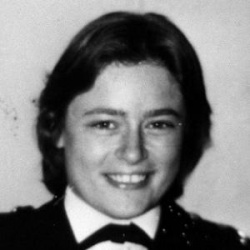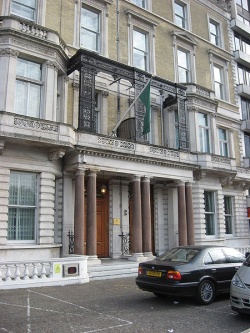Yvonne Fletcher
WPC Yvonne Joyce Fletcher (1959 – 17 April 1984) was a police officer who was shot and killed in London's St James's Square while on duty during a protest outside the Libyan embassy. Her death resulted in a police siege of the embassy, which lasted for eleven days. The shooting led to the breakdown of diplomatic relations between the United Kingdom and Libya. WPC Fletcher's death was the third murder or manslaughter of an on-duty mainland British policewoman in 18 months.[1]
Fletcher joined the Metropolitan Police in 1977. Nobody has ever been convicted of her murder.
Contents
Protests
On the day of her death, Fletcher was one of a detachment of thirty officers sent to St James's Square to monitor a demonstration by Libyan dissidents opposed to the rule of Colonel Gaddafi. The officers with her at the time included her fiancé. This particular demonstration was organised by the Libyan National Salvation Front (LNSF), and was in protest at the execution of two students who had criticised Gaddafi in Tripoli. The Libyan embassy, known as the Libyan People's Bureau, was located at 5 St James's Square. Gaddafi loyalists at the embassy had warned the police that they intended to mount a counter-demonstration.
About 75 protestors arrived by coach from the North of England for the demonstration, and the police kept them and the loyalists apart by the use of crowd control barriers. Loud music was played from the bureau in an apparent attempt to drown out the shouts of the protestors.[2]
Shooting
At 10:18 on the morning of 17 April 1984, shots were fired into the group of protestors, striking eleven people, including Fletcher. The unarmed officer died of a stomach wound approximately an hour after arriving at hospital. [3] [4]
The subsequent inquest into her death was told that Fletcher was killed by shots from two Sterling sub-machine guns from the first floor of the Libyan embassy.
Fletcher’s hat and four other police officers' helmets were left lying in the square during the ensuing siege on the embassy, and images of them were repeatedly shown on British and international television in the days that followed. The British public reacted with horror at the third murder of a British police officer in 18 months.
Siege
Following the shooting, the embassy was surrounded by armed police for eleven days, in the longest police siege in London's history. Meanwhile, Gaddafi expressed 'disgust' that his diplomats were not being permitted diplomatic immunity, and Libyan soldiers surrounded Britain's embassy in Tripoli in response.[5]
The British Government eventually resolved the incident by allowing the embassy staff to depart the bureau and then expelling them from the country. Britain then broke off diplomatic relations with Libya.
Subsequent events
In July 1999, the Libyan government publicly accepted 'general responsibility' for the murder and agreed to pay compensation to Fletcher's family. This, together with Libya's eventual efforts in the aftermath of the Lockerbie Bombing, opened the way for the normalisation of relations between the two countries.
On 24 February 2004, the Today Programme on BBC Radio 4 reported that the new Libyan prime minister, Shukri Ghanem, had claimed that his country was not responsible for her murder (nor for the Lockerbie bombing). Ghanem said that Libya had made the admission and paid compensation in order to bring 'peace' and an end to international sanctions.[6]
Controversy
The official view that Fletcher was fired upon and killed by someone in the Libyan embassy has been disputed by a number of experts, including army ballistics officer Lt-Col George Styles and Home Office pathologist, Hugh Thomas. Prime Minister Tony Blair was questioned on this subject by MP Tam Dalyell in Parliament on 24 June 1997. The Guardian of 23 July 1997 reported a parliamentary speech by Dalyell concerned mainly with the Lockerbie bombing, but also referring to Fletcher's murder:
"With the agreement of Queenie Fletcher, her mother, I raised with the Home Office the three remarkable programmes that were made by Fulcrum, and their producer, Richard Bellfield, called Murder In St. James's.[7] Television speculation is one thing, but this was rather more than that, because on film was George Styles, the senior ballistics officer in the British Army, who said that, as a ballistics expert, he believed that the WPC could not have been killed from the second floor of the Libyan embassy, as was suggested.
"Also on film was my friend, Hugh Thomas, who talked about the angles at which bullets could enter bodies, and the position of those bodies. Hugh Thomas was, for years, the consultant surgeon of the Royal Victoria hospital in Belfast, and I suspect he knows more about bullets entering bodies than anybody else in Britain. Above that was Professor Bernard Knight, who, on and off, has been the Home Office pathologist for 25 years. When Bernard Knight gives evidence on film that the official explanation could not be, it is time for an investigation."[8]
Participants who appeared in Channel 4's Dispatches documentary entitled Murder In St. James's highlighted such issues as the velocity of the bullet and the angle at which it entered Fletcher's body. Lt-Col Styles stated that a high velocity bullet from a Sterling submachine gun would have passed straight through her body at an angle of 15°, and Hugh Thomas rebutted evidence given by Ian West, the pathologist at the inquest, that the 60° angle of entry of the bullet could be explained by Fletcher's turning to the right or left. The film went on to allege that the anti-Gaddafi organisation Al Burkan, which was allegedly funded by the Reagan White House, had obtained a gun from the Hein terrorist group in West Berlin, and used it to kill Fletcher with a single shot from the sixth floor penthouse at 3 St James's Square - the building adjacent to the embassy. According to the film, the head of Al Burkan, Ragab Zatout, planned to overthrow Gaddafi and seize control of Libya's oil wealth after the severing of diplomatic relations, but his coup attempt on 8 May 1984 was thwarted by the Libyan army. [9] [10]
Her murder would later become a major factor in Prime Minister Margaret Thatcher's decision to allow U.S. President Ronald Reagan to launch the USAF bombing raid on Libya in 1986 from American bases in Britain.[11]
Murder investigation
Once diplomatic relations had been restored in 1999, officers from the Metropolitan Police went to Libya on a number of occasions to pursue their investigations into her murder.
In June 2007, detectives from Scotland Yard were able to interview the chief Libyan suspect for the first time, following the recent normalisation of political ties with that country.[12] Detectives spent seven weeks in Libya interviewing both witnesses and suspects. Fletcher's mother, Queenie, described these developments as "promising".
In February 2009, Queenie Fletcher suggested that Abdelbaset Ali Mohmed Al Megrahi, who at the time was appealing against his conviction for the Lockerbie Bombing, should be moved to a prison in Libya, on condition that the Libyan government co-operates with Scotland Yard detectives investigating her daughter’s murder. Mrs Fletcher said:
"I know he is ill and I think he should be returned to a prison in Libya so his family can visit him. The appeal could still go ahead in Scotland, but he could stay in prison in Libya. It’s got to be a fair exchange, so Yvonne’s case can be closed. I’d like the police here to be given permission to interview whoever they’ve got to interview in Libya and see whoever they need to for someone to be brought to trial." [13]
In October 2009 the Daily Telegraph revealed that the Crown Prosecution Service had been told by an independent prosecutor that there was sufficient evidence to prosecute two Libyans. A report from April 2007 concluded that the two men, who are now senior members of the Libyan regime played an "instrumental role" in the killing. [14]
See also
- Document:Terminal Velocity - "Were British & American intelligence involved in the murder of WPC Yvonne Fletcher?" - A study by David Guyatt
- Document:Yvonne Fletcher - Death in St James - Part 1 of Joe Vialls article
- Document:Yvonne Fletcher - Death in St James-2 - Part 2 of Joe Vialls article
References
- ↑ Police Memorial website
- ↑ ISBN 978-0886876784 Bloody business: an anecdotal history of Scotland Yard - page=255
- ↑ Yvonne Fletcher: BBC's account. The Guardian.
- ↑ Fiancé is witness. BBC News.
- ↑ Gaddafi's "disgust"
- ↑ PM Ghanem says Libya not responsible - BBC Radio 4, 24 February 2004
- ↑ Murder in St James's. Fulcrum TV
- ↑ Forensic evidence disputes that Fletcher was killed from second floor of Libyan embassy
- ↑ Libya: Exiled Opposition
- ↑ Dispatches - Murder In St. James's - Channel 4
- ↑ Statement by Margaret Thatcher on US bombing of Libya
- ↑ Yvonne Fletcher: the net closes in - The Guardian 24 June 2007
- ↑ Mum of shot WPC calls for Megrahi swap - The Sunday Times 1 February 2009
- ↑ Yvonne Fletcher: Tories demand Government answers over Libyan killers - The Daily Telegraph 16 Oct 2009
External links
- BBC News (March 25, 2004), "Timeline: WPC Yvonne Fletcher"
- The Murder of Policewoman Yvonne Fletcher Joe Vialls on the holes in the official story
- National Police Memorial image of the Fletcher memorial
- The Guardian (July 23, 1997), speech by Tam Dalyell on Lockerbie and Fletcher's murder
Footage
- Dispatches - Murder In St. James'. Channel 4 Dispatches investigation (since removed by YouTube).
- BBC News footage of the family reaction
- BBC footage of the funeral

